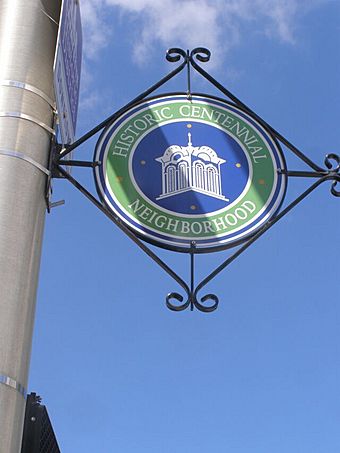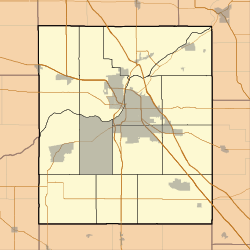Centennial Neighborhood District facts for kids
Quick facts for kids |
|
|
Centennial Neighborhood District
|
|

Street markers are located on major roads, entering the centennial historic district.
|
|
| Location | Roughly bounded by Union, 3rd, 4th, Ferry, and 9th Sts., Lafayette, Indiana |
|---|---|
| Area | 63 acres (25 ha) |
| Built | 1975-2000, 1950-1974, 1925-1949, 1900-1924, 1875-1899, 1850-1874, 1825-1849 |
| Architect | Multiple |
| Architectural style | Greek Revival, Queen Anne, Federal, Queen Anne |
| NRHP reference No. | 83003443 |
| Added to NRHP | June 16, 1983 |
The Centennial Neighborhood District is a special historic area. It is located in Lafayette, Indiana, in Tippecanoe County, Indiana. This district is recognized as a national historic place. It started as two areas called Bartholomew and Davis Additions in 1829.
The neighborhood grew quickly after the Wabash and Erie Canal arrived in 1843. More growth happened when the railroad came in 1853. The district gets its name from the Centennial School. This school was built in 1876. That year was the 100th birthday (centennial) of the United States. The school was at Brown Street and North 6th Street. Today, the school is gone, and a park is in its place.
Contents
Exploring the District's Past
The Centennial Neighborhood District began to grow in the 1830s. This was as Lafayette expanded north and east. The biggest growth spurt came with the Wabash and Erie Canal in 1843. The canal followed the path of Canal Road. Today, train tracks are on the west side of the neighborhood.
Canal Era Growth (1843-1853)
The canal brought many changes to the area. Mills, warehouses, and wharves were built. These places helped move goods along the canal. The oldest building in the district is the Reverend Samuel Johnson House. It was built in 1844. You can find it at the corner of Ferry and Sixth Streets. Another old house, the Richard DeHart House, was built in 1844 too. It is at 602 N. Fifth Street. The canal era ended when railroads arrived in 1853. Five houses still show what homes looked like during this time. They are at 716 and 729 Brown Street, 636 Ferry Street, and 713-715 North Fourth Street.
Railroad Boom (After 1853)
The first railroad, the Lafayette and Indianapolis Railroad, came to Lafayette in 1852. It ended several blocks south of this neighborhood. The New Albany and Salem Railroad, later called the Monon Railroad, arrived in 1853. This railroad followed Fifth Street. It really helped the neighborhood grow. In 1854, the Wabash Railroad also came through.
The railroads needed homes for their workers. A row house built in 1870 at 417-427 North Fourth Street shows this type of housing. Wealthier families built their homes along Ferry Street. Good examples are the Handley House at 632-634 Ferry Street and the Oppenheimer House at 604 North Sixth Street.
Churches and Schools
This district is known for its many churches and schools. St. John's Episcopal Church was built from 1851 to 1858. It is the oldest church still standing in the district. Other churches built in the 1860s and 1870s include St. James Lutheran Church, Trinity Methodist Episcopal Church, and St. Boniface Catholic Church. These churches were built in the Gothic Revival style.
Bethel African Methodist Episcopal Church started as Lafayette's first school for Black children. The Albert A. Wells Memorial Public Library was built in 1928. It is a great example of the Neoclassical style of building.
The Centennial Neighborhood District was added to the National Register of Historic Places in 1983. This means it is a very important place in American history.
Important Buildings to See
Here are some of the notable buildings in the Centennial Neighborhood District:
- 1844, Reverend Samuel Johnson House, 608 Ferry St.
- 1849, Bethel African Methodist Episcopal Church, 820 Ferry St.
- 1858, St. James Evangelical Lutheran Church, 800 Cincinnati Street
- 1858, St. Johns Episcopal Church, 600 Ferry Street
- 1865, St. Boniface Catholic Church, 318 N 9th Street
- 1869, Trinity United Methodist Church, 404 N 6th Street
- 1872, First Baptist Church, 411 N 7th Street St.
- 1876, Centennial School (demolished), 2007 Centennial Park, Centennial Park]], 501 N 6th Street
- 1893, Pottlitzer House, 801 Brown St.
- 1893, Wallace Bros. Building, 320 - 328 Ferry St.
- 1901, Monon Depot (Civic Theatre of Greater Lafayette), 328 N 5th Street
- 1908, St. Boniface Catholic School, 815 North Street
- 1913, First Christian Church, 329 N 6th Street
- 1914, Haywood Printing Company, 300 North 5th St.
- 1916, Sons of Abraham Synagogue, 661 North 7th St.
- 1928, Albert A. Wells Memorial Library, 638 North Street
Images for kids







